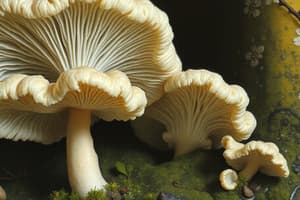Podcast
Questions and Answers
What structure facilitates the binding of RNA to initiate transcription?
What structure facilitates the binding of RNA to initiate transcription?
- TATA box (correct)
- RNA polymerase II
- Promoter region (correct)
- Ribosome
At what rate does transcription progress in eukaryotes?
At what rate does transcription progress in eukaryotes?
- 40 nucleotides per second (correct)
- 60 nucleotides per second
- 100 nucleotides per second
- 20 nucleotides per second
During transcription elongation, which end of the RNA strand do nucleotides get added to?
During transcription elongation, which end of the RNA strand do nucleotides get added to?
- 3' end (correct)
- 5' end
- Middle of the strand
- Both ends
How many RNA polymerases can transcribe a gene simultaneously?
How many RNA polymerases can transcribe a gene simultaneously?
What happens to the DNA helix during the elongation phase of transcription?
What happens to the DNA helix during the elongation phase of transcription?
Which of the following components is NOT part of the transcription initiation complex?
Which of the following components is NOT part of the transcription initiation complex?
What is the primary function of transcription factors in the transcription process?
What is the primary function of transcription factors in the transcription process?
What is the sequence orientation of the non-template strand of DNA during transcription?
What is the sequence orientation of the non-template strand of DNA during transcription?
Which class of Neurospora crassa mutants can grow with ornithine but cannot grow with citrulline or arginine?
Which class of Neurospora crassa mutants can grow with ornithine but cannot grow with citrulline or arginine?
What is the correct restatement of Beadle and Tatum's hypothesis regarding gene expression?
What is the correct restatement of Beadle and Tatum's hypothesis regarding gene expression?
Which of the following statements about feedback inhibition is true?
Which of the following statements about feedback inhibition is true?
Which class of mutants requires arginine to grow?
Which class of mutants requires arginine to grow?
Which amino acid is related to the precursor in all classes of Neurospora crassa mutants?
Which amino acid is related to the precursor in all classes of Neurospora crassa mutants?
What is the role of ribozymes in RNA processing?
What is the role of ribozymes in RNA processing?
Which of these proteins is not an enzyme?
Which of these proteins is not an enzyme?
What property of RNA enables it to function as an enzyme?
What property of RNA enables it to function as an enzyme?
What type of medium was used as a control in the experiment?
What type of medium was used as a control in the experiment?
What is alternative RNA splicing?
What is alternative RNA splicing?
How do introns contribute to gene expression regulation?
How do introns contribute to gene expression regulation?
Which class of mutants cannot grow at all in minimal medium?
Which class of mutants cannot grow at all in minimal medium?
Which type of mutation causes Class II mutants not to grow on citrulline?
Which type of mutation causes Class II mutants not to grow on citrulline?
What was a significant implication of the discovery of ribozymes?
What was a significant implication of the discovery of ribozymes?
What is a key difference between enzymes and proteins based on the revised hypothesis?
What is a key difference between enzymes and proteins based on the revised hypothesis?
What is the function of the spliceosome in RNA processing?
What is the function of the spliceosome in RNA processing?
Which of the following correctly describes the relationship between genes and proteins?
Which of the following correctly describes the relationship between genes and proteins?
Which of the following aspects is NOT a property of RNA that allows it to function catalytically?
Which of the following aspects is NOT a property of RNA that allows it to function catalytically?
What type of mutation involves a change in just one base pair of a gene?
What type of mutation involves a change in just one base pair of a gene?
Which of the following is true about nucleotide-pair substitutions?
Which of the following is true about nucleotide-pair substitutions?
What is the result of a mutation that changes a single nucleotide in a DNA template strand?
What is the result of a mutation that changes a single nucleotide in a DNA template strand?
Which of the following accurately describes the function of the signal recognition particle (SRP)?
Which of the following accurately describes the function of the signal recognition particle (SRP)?
What distinguishes sickle-cell hemoglobin from wild-type hemoglobin?
What distinguishes sickle-cell hemoglobin from wild-type hemoglobin?
Which of the following is NOT a type of small-scale mutation?
Which of the following is NOT a type of small-scale mutation?
The normal amino acid sequence in hemoglobin is altered in sickle-cell disease due to which of the following changes?
The normal amino acid sequence in hemoglobin is altered in sickle-cell disease due to which of the following changes?
What is the effect of a frame shift mutation compared to other mutation types?
What is the effect of a frame shift mutation compared to other mutation types?
How many codons function as stop signals during translation?
How many codons function as stop signals during translation?
What does it mean that the genetic code is redundant?
What does it mean that the genetic code is redundant?
What is the correct reading frame for codons?
What is the correct reading frame for codons?
Which of the following amino acids is encoded by the codon AUG?
Which of the following amino acids is encoded by the codon AUG?
Which statement about the genetic code is false?
Which statement about the genetic code is false?
What is the significance of the three stop codons?
What is the significance of the three stop codons?
In the context of mRNA, what does transcription refer to?
In the context of mRNA, what does transcription refer to?
How many amino acids do the 61 codons code for?
How many amino acids do the 61 codons code for?
What role do codons play in protein synthesis?
What role do codons play in protein synthesis?
What can be inferred about the evolutionary origin of the genetic code?
What can be inferred about the evolutionary origin of the genetic code?
What is the function of the start codon?
What is the function of the start codon?
Which of the following is true regarding the relationship between DNA and mRNA?
Which of the following is true regarding the relationship between DNA and mRNA?
Study Notes
Transcription
- The promoter facilitates the binding of RNA polymerase to initiate transcription.
- Transcription progresses at a rate of approximately 40 nucleotides per second in eukaryotes.
- Nucleotides are added to the 3' end of the RNA strand during transcription elongation.
- Multiple RNA polymerases can transcribe a gene simultaneously, allowing for efficient protein synthesis.
- During elongation, the DNA helix unwinds to expose the template strand for transcription.
- Transcription factors are NOT part of the transcription initiation complex.
- Transcription factors facilitate the binding of RNA polymerase to the promoter, thereby regulating gene expression.
- The non-template strand of DNA has the same sequence as the mRNA transcript, except for thymine being replaced by uracil.
Gene Expression and Mutations
- Class I Neurospora crassa mutants require arginine to grow.
- Class II mutants can grow with ornithine but not with citrulline or arginine.
- Beadle and Tatum's hypothesis states that one gene codes for one enzyme.
- Feedback inhibition occurs when the end product of a metabolic pathway inhibits an enzyme involved in its synthesis.
- Class III Neurospora crassa mutants cannot grow at all in minimal medium.
- The precursor amino acid related to all classes of Neurospora crassa mutants is ornithine.
RNA Processing and Function
- Ribozymes are catalytic RNA molecules involved in RNA processing.
- Proteins are not enzymes.
- The ability of RNA to form complex three-dimensional structures allows it to function as an enzyme.
- The minimal medium was used as a control in the experiment.
- Alternative RNA splicing allows for the production of multiple proteins from a single gene.
- Introns contribute to gene expression regulation by affecting RNA splicing and stability.
- Class II mutants have a mutation that prevents them from converting citrulline to arginine.
Implications of Ribozymes
- The discovery of ribozymes challenged the dogma that only proteins can catalyze biological reactions.
- The revised hypothesis states that some RNA molecules can act as enzymes, whereas proteins function as enzymes and other cellular roles.
- The spliceosome is a complex of RNA and proteins that removes introns from pre-mRNA.
Genes, Proteins and Mutations
- Genes code for proteins.
- The ability of RNA to base-pair with itself is not a property that enables it to function catalytically.
- A point mutation involves a change in a single base pair.
- Nucleotide-pair substitutions can result in silent, missense, or nonsense mutations.
- A mutation altering a single nucleotide in a DNA template strand can lead to a change in the amino acid sequence of a protein.
- The signal recognition particle (SRP) guides ribosomes synthesizing proteins destined for secretion to the ER.
- Sickle-cell hemoglobin differs from wild-type hemoglobin due to a single amino acid substitution.
- Insertions and deletions are not small-scale mutations.
- The substitution of valine for glutamic acid at position 6 in the beta globin chain leads to sickle-cell disease.
- A frameshift mutation can alter the reading frame of a gene and lead to a non-functional protein.
The Genetic Code
- Three codons function as stop signals during translation.
- The genetic code is redundant because multiple codons can code for the same amino acid.
- The reading frame is the set of three nucleotides that defines the codons.
- The codon AUG codes for methionine.
- The genetic code is not universal across all organisms.
- Stop codons signal the termination of protein synthesis.
Transcription and Translation
- Transcription refers to the process of synthesizing mRNA from DNA.
- There are 61 codons that code for amino acids.
- Codons dictate the order of amino acids in a polypeptide chain.
- The evolutionary origin of the genetic code suggests it is ancient and universal, indicating a common ancestor for all life.
- The start codon initiates protein synthesis.
- DNA contains the genetic information while mRNA transmits it to the ribosomes for protein synthesis.
Studying That Suits You
Use AI to generate personalized quizzes and flashcards to suit your learning preferences.
Related Documents
Description
Explore the experiment conducted on Neurospora crassa focusing on the growth of mutant cells in minimal media. This quiz covers the classification of mutants based on their ability to grow with various supplements and the corresponding gene functions involved in arginine biosynthesis. Test your understanding of the one gene – one polypeptide hypothesis as it relates to enzyme production.



